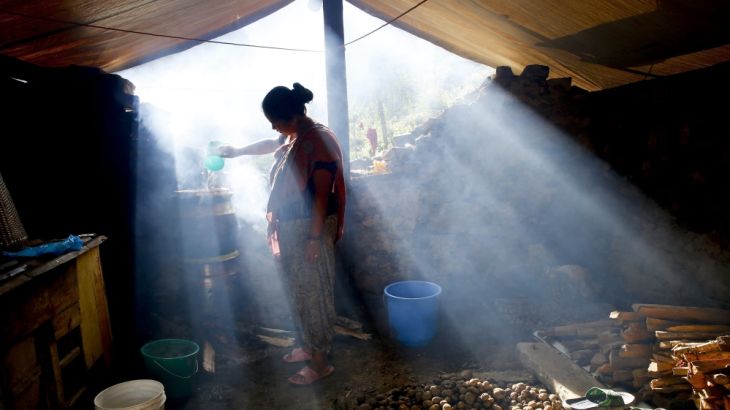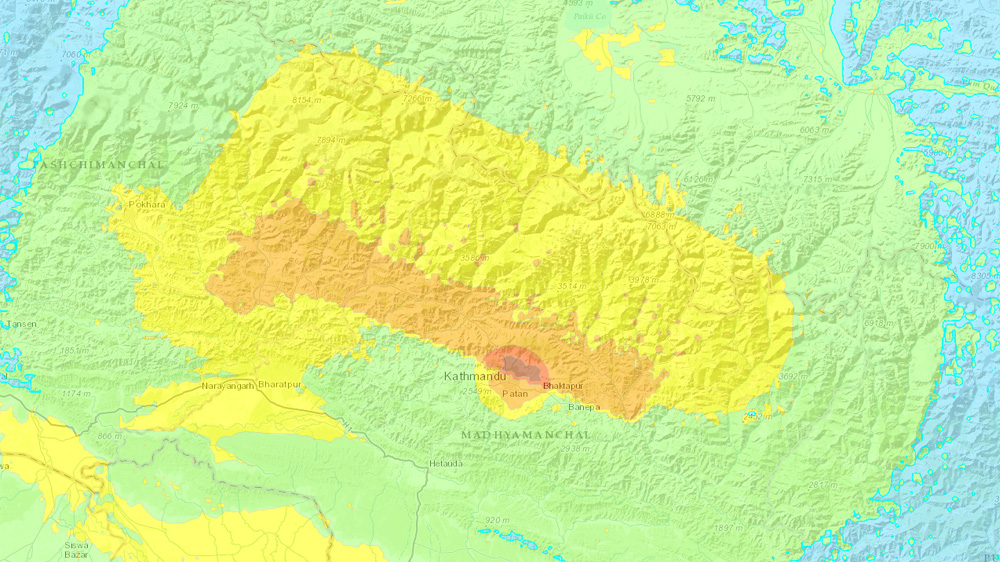Nepal earthquake’s open wounds
The tremors might have stopped, but even after a year fear has not left many in a country of dysfunctional government.

On the streets, there are rumours. At shops, people murmur to each other that there is a plague of earthquakes going around the world.
Some are convinced that the quake is coming back to Nepal.
Keep reading
list of 4 itemsHow is Afghanistan coping six months after deadly quakes?
‘Violent rumble’: 4.8 magnitude earthquake rattles New York City, northeast
Taiwan searches for 18 still missing after Wednesday’s earthquake
“None of the tailors are back,” says the local seamstress, explaining that her staff have left the city.
“They’re waiting for Baishakh 12,” the Nepali date when the devastating quake shook Nepal last year.
The tremors might have stopped, but even after a year the fear has not left many of us.
READ MORE: The story I wish I never had to tell
Visual reminders of the quake are like open wounds.
As you drive from Kathmandu to Sindhupalchowk, ruins of homes and lives lie scattered along the hills and the mountains.
The survivors are still living in shabby temporary shelters that keep neither the heat nor the cold away.
That day, April 25, 2015, the earth shook for around a minute.
Around 9,000 people died, and millions were left homeless.
One of the first stories we told was of Suresh, a young man, a migrant worker, who lost a daughter.
Lost and heartbroken
Suresh was coming back from Qatar, totally lost, and heartbroken.
On our journey to Dhading, Suresh’s eyes would glisten with tears.
At home, his wife was devastated and her tears moved all of us.
Resilience is a word that I hate by now.
|
|
Every time some government officer says that Nepalis are resilient and therefore will survive the worst, it makes me angry.
For Nepalis, the choice is to survive or not to survive, and they’ve had very little support from the government.
Resham, a man from Sindhupalchowk who lost his wife and son, told me: “We have no government in Nepal.”
He said the men in power were there to serve themselves.
Looking back on the year, it’s clear he’s largely right.
By June, the government managed to get a pledge of $4.1bn from the international community to rebuild Nepal.
But as soon as the money was committed, it was as if the quake was forgotten.
Everyone wanted a share of the pie, and politicians went on to rush out a controversial new constitution and form a new government.
Protests erupted in the Madhesh, the plains of Nepal and the country became deeply polarised.
Dozens of protesters got shot, and ten policemen were also killed.
Empathy hard to find
|
|
| Nepal mourns protesters killed in rallies |
Empathy for protesters was hard to find in the capital Kathmandu.
On one side, margnalised communities, especially the Madhesis, demanded better representation under the constitution, while many members of traditionally dominant castes hailed the constitution as the best in the world.
In Birgunj one man said: “We gave a day’s salary to support the quake victims. Who will support us?”
That support never came. Come September 20, after 44 people had died, the constitution was promulgated amid celebrations in Kathmandu.
READ MORE: Nepal earthquake survivors face winter’s cold
It was a difficult moment to report. While people were dancing around me, I heard news about one more protester being shot dead in the south.
It was clear that the rage in the Tarai would be further fuelled.
Like all Nepalis, I had my own reason to feel personally about the constitution, because it made men and women unequal citizens.
Women cannot pass on their citizenship to their children as easily as men can. There are more than four million undocumented Nepalis who are effectively stateless.
A perfect mess
India stepped in. There was a “blockade” on imports.
Fuel, and even food became scarce and people in Kathmandu started to suffer visibly.
It was a perfect mess – and it gave the government a perfect excuse not to do anything for the earthquake survivors.
While all this was going on, around eight months after the quake, those in power could not even agree how to set up the National Reconstruction Authority, which would be responsible for rebuilding Nepal.
Without the reconstruction authority, there were no approved designs for houses, and no funds released.
|
|
In the winter, we stayed in Laprak in Gorkha district, near the epicentre of the quake.
In this village, at over 3,000 metres in elevation, snow would fall occasionally and chill the bones.
There was nowhere in the village that was remotely warm.
After the quake, many men from Laprak left to work as migrants and the women and children huddled around fires, rubbing their bodies with oil at night to keep themselves warm.
Non-governmental organisations distributed blankets and sleeping bags, but nothing kept the cold out.
I have never felt the cold as I did there.
A year on, the government has not facilitated the building of even one house.

Over the year, people’s lives have changed.
Just a few weeks ago, Suresh, the migrant labourer I had reported on, came to visit.
He had returned again from Qatar when he heard that his wife had left him.
Families torn apart
Suresh was heartbroken once more. On the phone, his wife Sumina cried.
The line was crackling – and then it went dead.
A year ago, they were a family of four. With one dead, they are now broken apart.
Physical wounds have healed but the psychological damage is deep.
Resham, who lost his wife and child, says he sweats all night and tosses and turns, unable to sleep.
He says he wants to run away.
But trapped in the nightmare of the aftermath of a quake, and the endless dysfunction of politics and government, a year after the disaster there is nowhere to run to, nowhere to go.